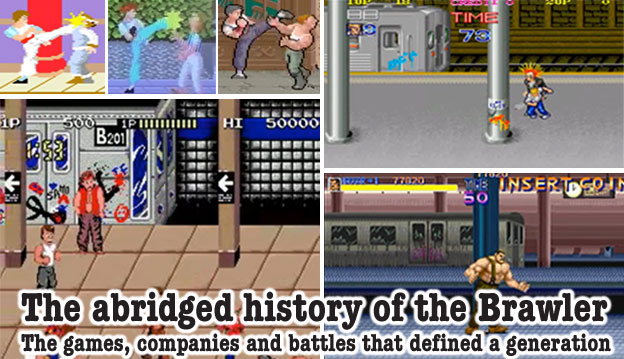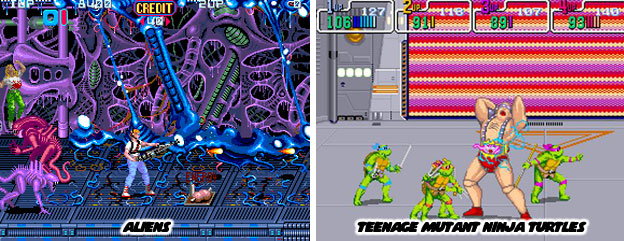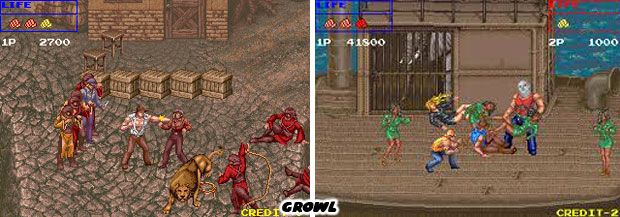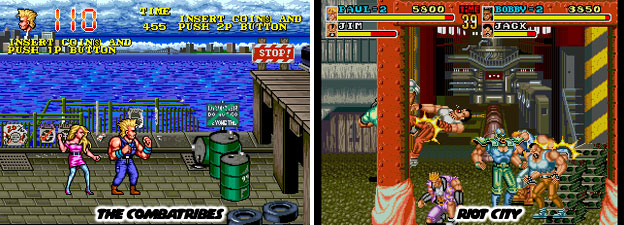
Good arcade games based on movies or TV shows were very sparse. Great licensed brawlers were even rarer. Konami changed all of that in the end of 1989 by releasing an arcade version of the wildly popular Teenage Mutant Ninja Turtles cartoon. This game was far more memorable than Crime Fighters, their previous brawling effort.
The game was layered with amazing details pulled right from the cartoon series. Plenty of gags, inside jokes, sound bites and hidden animations were crammed into the game. It was fanservice of the highest caliber, but it was quality fanservice that tried out new directions for the genre. The majority of the game was the traditional brawling experience. However that branched out when players were zipping down the streets fighting the evil Foot Clan on rocket powered skateboards. The illusion of moving quickly through a location while still being able to fight opponents with the existing play mechanics had not been done better than that previously. Konami was definitely onto something with this game.

In 1990 Konami turned Aliens, a groundbreaking science fiction movie, into a different type of brawler. Despite being two completely different types of subject matter, the lessons they learned from TMNT were carried over into Aliens. They preserved the attention to detail from canon and shaped that as a game narrative.
Where Aliens differed from the other brawlers was that the players did not use their hands or feet. Instead programmers put different types of high powered machine guns in the hands of players. Several of these weapons were pulled right from the movie. Each gun, rather than each player, had its own effective range, strength and weakness. This distinction made for a unique gameplay element. In the traditional brawler each player was free to explore the screen and take on any rival they could. It was very much every man for himself in those games. In Aliens some of the species took several shots to put down and by that time there would be another following it or sneaking up on the player from the opposite direction. Gamers that worked closely together, perhaps one with a short range flamethrower and one with a long range assault cannon could get further into the game than players that went on their own.
That year was not filled entirely with great advances in the genre. Studios were quickly developing their own take on the brawler and they weren’t all great or memorable. Several were applying the formula as fast as they could and pushing a title right to market. That was the sense I got from Taito when they released GROWL. A brawler set in the '30s-'40s about a group of adventurers tackling poachers in the jungle. The game was a thinly-veiled Indiana Jones rip off as scores of thugs went after fedora wearing heroes.

The handful of rival designs had nothing more than color palette swaps. Random men and women wearing the same costumes in different colors would simply show up to fight players over and over. The only interesting elements going for the brawler were some of the stage designs. Fighting aboard a steam ship as it sailed down a river, or atop a train as it sped through the jungle made for memorable levels. Everything aside from that was truly forgettable.
Technos was guilty of exploiting their own Double Dragon formula when it released the Combatribes. They added a third, black character, to the lineup of Billy and Jimmy Lee clones just to keep things fresh. I will go on record to say that the first time I saw the famous Guile haircut from Street Fighter II. It was with the blonde character in the game a full year before Capcom revolutionized the fighting genre. Granted the graphics and animation were improved over Double Dragon, but the case was true for every other game released three years after Double Dragon.
The things that made this game unique had to do with the combat system. Downed opponents could be kicked, picked up or swung around by the ankle. Swinging opponents around and throwing them into each other was truly my favorite part. Rarely did brawling games allow for rivals to be struck while they were down. If they were allowed to fight dirty why couldn’t the players be allowed the same luxury? The game also exploited the health allowance that Konami charged in Crime Fighters. Quarters granted players a set amount of health. Thankfully unlike Konami that health did not go down by the second.
After Konami had pushed the genre forward with TMNT and Aliens players had an elevated expectation for brawlers. Taito and Technos seemed to have missed that expectation and as such GROWL and Combatribes saw a limited following. The next year would be the defining moment for the brawler. Unfortunately it got off to a rough start.

Westone (a publisher I never heard from again) developed a game for Sega. Riot City would be one of the companies first forays into the genre. The game was a pretty forgettable brawler, with a questionable design team and lackluster graphics.
About the only thing I remember from the game was the funny strut that the black character had. I guess he had to be even cooler than the white guy in the game so he walked like a rooster. Seriously Sega, what was that all about? Thankfully the rest of 1991 would give Sega another chance to get things right. In fact every major developer and publisher seemingly released at least one brawling game that year. Some were fantastic, some were okay and a few ones were real stinkers. We shall explore these over the next few blogs.
As always if you enjoyed this podcast and would like to sponsor me please visit my Patreon page and consider donating each month, even as little as $1 would help make better entries!

No comments:
Post a Comment